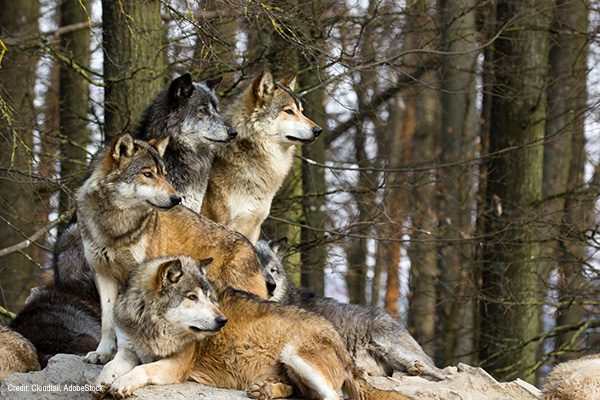
Oct 10, 2024 Changing Attitudes and Conflicts Over Wolf Management
WellBeing News has published three articles on the changing attitudes towards wolves and the conflicts arising from wolf management in North America: The Wolf Pendulum in the United States, May 10, 2021, Human-Wolf Conflict and Wolf Protection, January 31, 2022, and Wolves Revisited, March 2, 2022. A similar debate over the presence of wolves is emerging in Europe. Wolves provoke strong positive and negative emotions in Europe and the United States and are important indicators of how humans perceive nature and our role in the natural order. In Europe and North America, the fear of wolves is often ingrained in children’s education through stories like The Three Little Pigs and Little Red Riding Hood. Interestingly, the Rowan children preferred the award-winning 1993 parody, The Three Little Wolves and the Big Bad Pig.

Wolf pack | Credit: Cloudtail, AdobeStock
In the mid-1990s, wolves were reintroduced into Yellowstone National Park in the USA. By 2003, the United States Fish and Wildlife Service (FWS) started working to remove the wolf from the protections of the 1973 Endangered Species Act due to the growing wolf population in the country. After eighteen years of debates, lawsuits, and back-and-forth arguments between wolf advocates and opponents, the FWS’s final rule to delist the wolf in the lower 48 states became effective on January 4, 2021. Despite the rule’s passage, there have been ongoing court challenges in recent years.
A recent study on Canadian attitudes towards wolves was published. The authors reported that overall, Canadians have a positive attitude toward wolves (70% of respondents), regardless of age, gender, province of residence, and political preference. The authors argued that, unlike in the United States, where wolves were largely eliminated from nearly all lower 48 states, the Canadian wolf population was never eliminated. Around 60,000 individuals are spread across 80% of the original Canadian wolf habitat. The authors suggested that the American attitude and the heated conflict between wolf advocates and opponents may have been worsened by the absence of wolves in nearly all of America, followed by their reintroduction to states in the Midwest and the Northern Rockies.
In Europe, efforts to reduce the protection of the recovering wolf population, now estimated to number more than 21,000 individuals, may have been influenced by the killing of an aging 30-year-old pony named Dolly by a wolf in the state of Lower Saxony in Germany late in 2022. Dolly was a cherished pet of the von der Leyen family, one of whom, Ursula von der Leyen, is the President of the European Commission. A year after Dolly’s death, von der Leyen announced plans to reduce legal protections in the European Union for the wolf under the Bern Convention from ‘strictly protected’ to ‘protected.’ Such an action would be similar to the United States FWS’s proposal to downgrade wolf protection in the USA under the Endangered Species Act.
The European Union also commissioned a detailed analysis of wolf populations in the region, published in December 2023. According to the report, wolves were extirpated from most of Europe in the 18th and 19th centuries but began to return in the 1970s. Wolves were present in 21 EU countries from 2013 to 2018, and the total population was estimated to be between 11,000 and 17,000 (with 13,492 wolves being the best estimate). It is difficult to estimate precisely the number of wolves in a country. Still, of 39 regional conservation status assessments in Europe, 18 reported an improving (favorable) conservation status for wolves, while 19 were unfavorable and 2 had an unknown status. In 2023, wolves had been reported in all EU countries except Ireland, Cyprus and Malta. The UK left the EU but also has no wolves.
The EU report highlights that the main threat to wolves in the EU is the intentional and unintentional (e.g., road accidents) killing of wolves by humans. Additionally, conflicts between humans and wolves arise mainly from wolf predation on livestock. Each year, wolves in the EU are responsible for the deaths of approximately 65,000 livestock animals, with the majority being sheep and goats. The predation of sheep by wolves accounts for about 0.065% of the total sheep population in the EU. Farmers have adjusted their animal management practices as the wolf population has expanded. In Germany, such adjustments resulted in a significant decrease in wolf attacks. Although the overall impact of wolves on livestock in the EU is minimal, the report emphasizes that “the pressure on rural communities can be high in certain areas.”
It is widely claimed that wolves do not attack people. However, a recent Norwegian report investigated such claims and found evidence from the period 2002 to 2020 of 12 wolf attacks on people in Europe and North America. Of the 12 attacks, there were two fatalities in North America. The authors commented that with nearly 60,000 wolves in North America and 15,000 in Europe coexisting with hundreds of millions of people, the risks of a wolf attack on a person are above zero but are too low to calculate.
Farmers generally dislike predators and want them removed from the environment. However, Robert Schmidt, an emeritus faculty member of the College of Natural Resources at Utah State University, reports that the opposition from wolf opponents is driven by hatred of wolves, a much more powerful emotion than dislike. Fortunately, some approaches can overcome hatred and finger-pointing to produce wolf management plans agreed upon by wolf opponents and advocates. Francine Madden of the Center for Conservation Peacebuilding enthusiastically engaged in the wolf debates in the Northern Rocky Mountains at the request of the FWS. While she has described the wolf issue as the “Middle East” of wildlife conflicts, her wolf dialogue project was successful. In Europe, an academic group at Aarhus University in Denmark also launched a dialogue project to defuse human conflict over wolves and wolf policy as wolves start to move into the country from Germany.
While it may seem that managing wolf populations is a complex issue, Madden and the team in Denmark offer real-life examples showing that conflicts over wolves can be resolved without resorting to divisive lawsuits. By using innovative methods, constructive agreements that satisfy all parties involved can be reached.
Top Image Credit: Twitchy Films, AdobeStock


